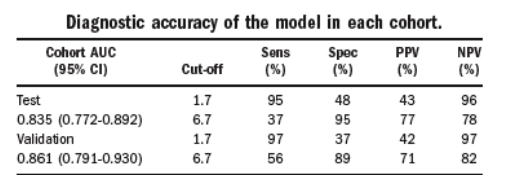 |
 |
 |
| |
THE PERFORMANCE OF APRI FOR THE DIAGNOSIS OF SIGNIFICANT HEPATIC FIBROSIS IS IMPROVED BY A SIMPLE MODIFICATION
|
| |
| |
Reported by Jules Levin
http://www.natap.org
from AASLD
Nov 11, 2005, San Francisco
Oren K. Fix, Boston Medical Center, Boston, MA; C. R. Horsburgh, Timothy C. Heeren, Boston University School of Public Health, Boston, MA; John F. Reinus, Edward Garcia, Montefiore Medical Center, Bronx, NY; Daniel S. Mishkin, Boston
Medical Center, Boston, MA; Camilla S. Graham, Margaret J. Koziel,
Beth Israel Deaconess Medical Center, Boston, MA; David P. Nunes,
Boston Medical Center, Boston, MA
Background: The AST-platelet ratio index (APRI) is a useful noninvasive
marker of hepatic fibrosis in patients with chronic hepatitis C (CHC). The aim of this study was to develop a predictive model of clinically significant fibrosis using factors routinely measured in patients with CHC.
Methods: This was a retrospective analysis of consecutive liver biopsies for evaluation of CHC at Boston Medical Center (test cohort) and Montefiore Medical Center (validation cohort). Biopsies were excluded for HIV infection and biopsy length <1 cm. Biochemical and clinical factors were analyzed for their ability to
predict significant fibrosis (Ishak fibrosis stage >/=3). A model was constructed in the test cohort combining the independent predictors from a multivariate analysis. Optimal cut-off values were identified and the diagnostic ability of the model was described in the validation cohort and compared with the APRI.
Results:
There were 216 liver biopsies in the test cohort and 125 in the validation cohort. The prevalence of significant fibrosis was 30% in both cohorts. After multivariate analysis, age, albumin, AST, and platelets were identified as independent predictors of significant fibrosis. The proportional relationships of these variables
to fibrosis were used to construct a model, (age*AST)/(albumin*platelets). The area under the ROC curve (AUC) was 0.835 (95% CI: 0.772-0.892) in the test cohort and 0.861 (0.791-0.930) in the validation cohort. Using a cut-off of 1.7, clinically significant fibrosis was excluded with a high degree of accuracy (negative predictive value of 96%) in the test cohort. A cut-off of 6.7 had a
positive predictive value of 77% for the diagnosis of significant fibrosis. Applying the model to the validation cohort would have avoided biopsies in 51% of the cohort with a similar degree of certainty (see table). The model correctly identified 44% of the subjects in both cohorts combined. The addition of age and albumin increased the diagnostic performance of APRI significantly in both cohorts combined, with an AUC of 0.841 (0.795-0.885) for the model and 0.809 (0.759-0.859) for APRI (p<0.0001).
Conclusions: Modification of APRI with the inclusion of age and albumin significantly improved its diagnostic performance in both the test and validation cohorts. This study shows that these simple noninvasive markers have sufficient diagnostic value to be useful in guiding clinical decision-making with respect to liver biopsy and treatment.

|
|
| |
| |
|
 |
 |
|
|